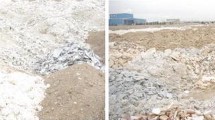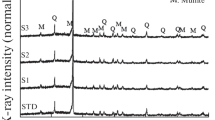Abstract
Natural stones are exposed to various physical, chemical and environmental interactions during service life. It is quite important to determine physico-mechanical properties of natural stones for specific applications. This paper presents an experimental study conducted to explore effect of acid and sulfate shocks on some physico-mechanical properties and color of natural stones. For this purpose, five different building stones used as marble (Malatya Beige, Ağrı Onyx, Adıyaman Crystal Emperador, Diyarbakır Black Pearl, Elazığ Rosso Levanto) were supplied from eastern region of Turkey. Point load strength, Schmidt hardness rebound, unit weight, porosity, water absorption and color measurements were conducted on provided natural stones. Additionally, mineralogical properties of natural stones were investigated with XRD and XRF analyses. Then, these natural stones were exposed to chemical shocks with 5% H2SO4 and Na2SO4 solutions for 0, 10, 20 and 30 cycles. Changes in Schmidt hardness, point load strength, porosity, dry weight and color after chemical shock cycles were investigated. Experimental results showed that Diyarbakır Black Pearl (DBP) and Malatya Beige natural stones might be used in aggressive H2SO4 and Na2SO4 environments for structural and ornamental purposes. After 30 cycles of H2SO4 and Na2SO4 shock, minimum decrease in point load values was obtained from DBP samples with 5.97% and 9.15%, respectively. Similarly, decrease in Schmidt harness values of DBP was minimum. Among natural stones exposed to H2SO4 and Na2SO4 shocks, AO sample that had the greatest strength loss was 17.36% and 9.68%, respectively.











Similar content being viewed by others
References
Barone G, Mazzoleni P, Pappalardo G, Raneri S (2015) Microtextural and microstructural influence on the changes of physical and mechanical proprieties related to salts crystallization weathering in natural building stones. The example of Sabucina stone (Sicily). Constr Build Mater 95:355–365. https://doi.org/10.1016/j.conbuildmat.2015.07.131
Scrivano S, Gaggero L, Gisbert Aguilar J (2018) Micro-porosity and mineropetrographic features influences on decay: experimental data from four dimension stones. Constr Build Mater 173:342–349. https://doi.org/10.1016/j.conbuildmat.2018.04.041
Navarro R, Pereira D, Gimeno A, Del Barrio S (2018) Influence of natural carbonation process in serpentinites used as construction and building materials. Constr Build Mater 170:537–546. https://doi.org/10.1016/j.conbuildmat.2018.03.100
Jian-bin L, Zhong-jian Z, Biao L (2019) Microscopic & macroscopic characterizations of Beijing marble as a building material for UNESCO heritage sites: new insights into physico-mechanical property estimation and weathering resistance. Constr Build Mater 225:510–525. https://doi.org/10.1016/j.conbuildmat.2019.07.094
Cardenes V, Mateos FJ, Fernandez-Lorenzo S (2014) Analysis of the correlations between freeze-thaw and salt crystallization tests. Environ Earth Sci 71:1113–1134. https://doi.org/10.1007/s12665-013-2516-7
Vazquez P, Luque A, Alonso FJ, Grossi CM (2013) Surface changes on crystalline stones due to salt crystallization. Environ Earth Sci 69:1237–1248. https://doi.org/10.1007/s12665-012-2003-6
Careddu N, Marras G (2013) The effects of solar UV radiation on the gloss values of polished stone surfaces. Constr Build Mater 49:828–834. https://doi.org/10.1016/j.conbuildmat.2013.09.010
Cardell C, Benavente D, Rodriguez-Gordill J (2008) Weathering of limestone building material by mixed sulfate solutions. Characterization of stone microstructure, reaction products and decay forms. Mater Charac 59:1371–1385. https://doi.org/10.1016/j.matchar.2007.12.003
Ross M, McGee ES, Ross DR (1989) Chemical and mineralogical effects of acid deposition on Shelburne Marble and Salem Limestone test samples placed at four NAPAP weather-monitoring sites. Am Mineral 74:367–383
Sarıısık A, Sarıısık G (2011) Environmental interaction properties of marble used in the restoration of historical monuments (Dalyan-Kaunos). Ekoloji 20(79):12–20. https://doi.org/10.5053/ekoloji.2011.792
Vazquez P, Carrizo L, Thomachot-Schneider C, Francisco SG, Alonso J (2016) Influence of surface finish and composition on the deterioration of building stones exposed to acid atmospheres. Constr Build Mater 106:392–403. https://doi.org/10.1016/j.conbuildmat.2015.12.125
Grossi CM, Alonso FJ, Esbert RM, Rojo A (2007) Effect of laser cleaning on granite color. Color Res Appl 32(2):152–159. https://doi.org/10.1002/col.20299
Royer-Carfagni GF (1999) On the thermal degradation of marble. Int J Rock Mech Min Sci 36:119–126. https://doi.org/10.1016/S0148-9062(98)00169-7
Ozguven A, Ozcelik Y (2014) Effects of high temperature on physico-mechanical properties of Turkish natural building stones. Eng Geol 83:127–136. https://doi.org/10.1016/j.enggeo.2014.10.006
Eren-Sarici D (2016) Thermal deterioration of marbles: gloss, color changes. Constr Build Mater 102:416–421. https://doi.org/10.1016/j.conbuildmat.2015.10.200
Török A, Rozgonyi N (2004) Morphology and mineralogy of weathering crusts on highly porous oolitic limestones, a case study from Budapest. Environ Geol 46(3–4):333–349. https://doi.org/10.1007/s00254-004-1036-x
Ausset P, Del Monte M, Lefevre RA (1999) Embryonic sulphated black crusts on carbonate rocks in atmospheric simulation chamber and in the field: role of carbonaceous fly-ash. Atmos Environ 33:1525–1534. https://doi.org/10.1016/S1352-2310(98)00399-9
Gökay MK, Gundogdu IB (2008) Color identification of some Turkish marbles. Constr Build Mater 22(7):1342–1349. https://doi.org/10.1016/j.conbuildmat.2007.04.016
Massey SW (1999) The effects of ozone and NOx on the deterioration of calcareous stone. Sci Total Environ 227(2–3):109–121. https://doi.org/10.1016/S0048-9697(98)00409-4
Müller U (2008) The mineralogical composition of sandstone and its effect on sulphur dioxide deposition. Mater Constr 58:81–95. https://doi.org/10.3989/mc.2008.v58.i289-290.86
Lipfert FW (1989) Atmospheric damage to calcareous stones: comparison and reconciliation of recent experimental findings. Atmos Environ 23(2):415–429. https://doi.org/10.1016/0004-6981(89)90587-8
Sweevers H, Van Grieken R (1992) Analytical study of the deterioration of sandstone, marble and granite. Atmos Environ Part B Urban Atmos 26(2):159–163. https://doi.org/10.1016/0957-1272(92)90019-O
Grossi CM, Murray M, Butlin RN (1995) Response of porous building stones to acid deposition. Water Air Soil Pollut 85(4):2713–2718. https://doi.org/10.1007/BF01186244
Bonazza A, Messina P, Sabbioni C, Grossi CM, Brimblecombe P (2009) Mapping the impact of climate change on surface recession of carbonate buildings in Europe. Sci Total Environ 407(6):2039–2050. https://doi.org/10.1016/j.scitotenv.2008.10.067
Sharma PK, Khandelwal M, Singh TN (2007) Variation on physico-mechanical properties of Kota stone under different watery environments. Build Environ 42:4117–4123. https://doi.org/10.1016/j.buildenv.2006.11.032
Alves C, Figueiredo C, Mauricio A, Braga MAS, Aires-Barros L (2011) Limestone under salt decay test: assessment of pore network-dependent durability predictors. Environ Earth Sci 63:1511–1527. https://doi.org/10.1007/s12665-011-0915-1
Lubelli B, De Rooij MR (2009) NaCI crystallization in restoration plasters. Constr Build Mater 23:1736–1742. https://doi.org/10.1016/j.conbuildmat.2008.09.010
Sarıısık A, Sarıısık G, Senturk A (2010) Characterization of physical and mechanical properties of natural stones affected by ground water under different ambient conditions. Ekoloji 19(77):88–96. https://doi.org/10.5053/ekoloji.2010.7713
Sariisik A, Sariisik G (2010) Quality control of Turkish calcareous natural stone using the merkont system. J Test Eval 38(5):575–587. https://doi.org/10.1520/JTE102774
TS EN 1936 (2010) Natural stone test methods- Determination of real density and apparent density and of total and open porosity. Turkish Standardization Institute, Ankara (in Turkish)
TS EN 13755 (2009) Natural stone test methods - Determination of water absorption at atmospheric pressure. Turkish Standardization Institute, Ankara (in Turkish)
TS 6809 (2012) Determination of scratch hardness according to Mohs Scale. Turkish Standards Institution (TSE), Ankara (in Turkish)
TS EN 14066 (2015) Natural stone test methods - Determination of resistance to ageing by thermal shock, Turkish Standards Institution (TSE), Ankara (in Turkish)
ISRM (1985) Suggested method for determining point load strength. Int J Rock Mech Min Sci Geomech Abstr 22:51–60. https://doi.org/10.1016/0148-9062(85)92327-7
Kahraman S, Fener M, Gunaydin O (2002) Predicting the schmidt hammer values of in-situ intact rock from core sample values. Int J Rock Mech Min Sci 39:395–399. https://doi.org/10.1016/S1365-1609(02)00028-X
ISRM (1978) Suggested methods for determining hardness and abrasiveness of rocks. Int J Rock Mech Min Sci Geomech Abstr 15:89–97. https://doi.org/10.1016/0148-9062(78)91509-7
Sousa LMO, Gonçalves BMM (2013) Differences in the quality of polishing between sound and weathered granites. Environ Earth Sci 69:1347–1359. https://doi.org/10.1007/s12665-012-2035-y
Ozguven A, Ozcelik Y (2013) Investigation of some property changes of natural building stones exposed to fire and heat. Constr Build Mater 38:813–821. https://doi.org/10.1016/j.conbuildmat.2012.09.072
Taghipour M, Nikudel MR, Farhadian MB (2015) Engineering properties and durability of limestones used in Persepolis complex, Iran, against acid solutions. Bull Eng Geol Environ. https://doi.org/10.1007/s10064-015-0821-y
Farrokhrouz M, Asef MR (2017) Experimental investigation for predicting compressive strength of sandstone. J Nat Gas Sci Eng 43:222–229. https://doi.org/10.1016/j.jngse.2017.03.023
Atapour H, Mortazavi A (2018) The influence of mean grain size on unconfined compressive strength of weakly consolidated reservoir sandstones. J Petr Sci Eng 171:63–70. https://doi.org/10.1016/j.petrol.2018.07.029
Özdemir E, Eren Sarici D (2018) Combined effect of loading rate and water content on mechanical behavior of natural stones. J Min Sci 54:931–937. https://doi.org/10.1134/S1062739118065072
Kahraman S, Gunaydin O, Fener M (2005) The effect of porosity on the relation between uniaxial compressive strength and point load index. Int J Rock Mech Min Sci 42:584–589. https://doi.org/10.1016/j.ijrmms.2005.02.004
Author information
Authors and Affiliations
Corresponding author
Ethics declarations
Conflict of interest
The authors declare that they have no confict of interest.
Rights and permissions
About this article
Cite this article
Özdemir, E., Kantarcı, F. & Eren Sarıcı, D. Effects of acid–base solutions on some Turkish natural building stones: physico-mechanical and color changes. Innov. Infrastruct. Solut. 7, 103 (2022). https://doi.org/10.1007/s41062-021-00698-4
Received:
Accepted:
Published:
DOI: https://doi.org/10.1007/s41062-021-00698-4




